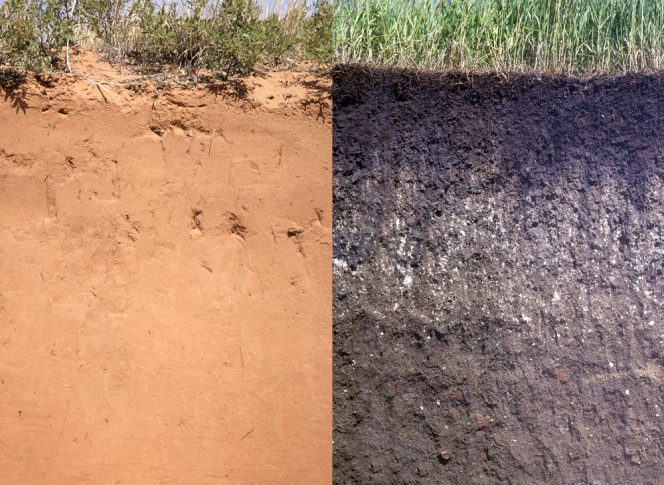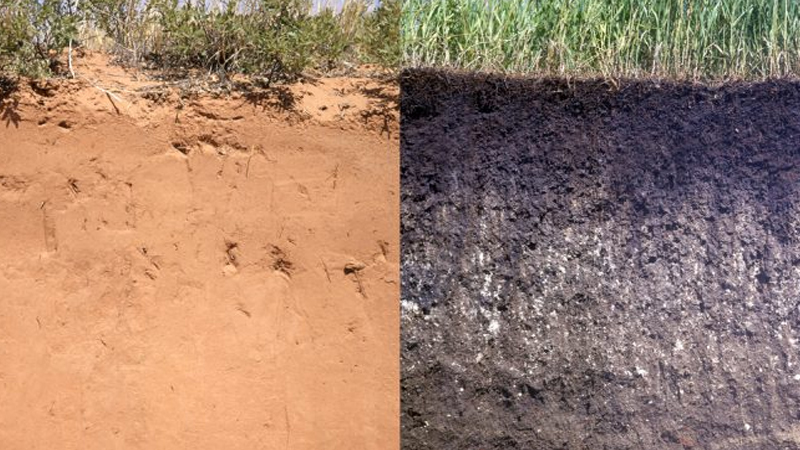 Sally Brown
Sally Brown
What happens when you add organic matter to soil? Here I am talking about organic matter that derives from the plants that we took from the soil in the first place. That category includes compost but doesn’t stop there. Digestates are all the rage at the moment but cows were into anaerobic digestion long before digesters became a fixture in cities. Animal manures, pulp sludges, and municipal biosolids all count as materials that originally started as plants growing in soil.
Those plants growing in soil are part of the short-term carbon cycle. Give a seed some rain, sunlight and soil and it starts to grow. Over time, or with the coming of winter, the plant will go dormant or die. All of the leaves, stalks, stems and roots it has accumulated with the carbon and nutrients they contain will be returned back to the soil. A large portion will be eaten by worms and microbes, with a small portion remaining in the soil.
As the fixed carbon is eaten, the animals (microbes, worms, mice, etc.) that eat it release carbon dioxide (CO2) back to the atmosphere until the next growing season. The CO2 released by the annual cycle of growth and decay is considered to be part of the short-term carbon cycle and does not figure into the carbon accounting books. That is why CO2 released from composting piles is not something to lose sleep over. The feedstocks for composting are typically from the short-term carbon cycle and are expected to be eaten and released.

Entisoils (left) are “baby soils” of recent origin. Mollisols (right) result from long-term addition of organic materials. Images courtesy of USDA
Messing With The Short-Term Cycle
Things start to go off balance with this short-term cycle when the stuff that grows isn’t allowed to decay in place. Think of this as the difference between a prairie and a wheat field. In a prairie the grasses grow, die and decay in place. The decaying plant matter enriches the soil making it easy for new grass to grow. Animals that live in the prairie eat and poop in place. Again, the wastes are treated in place and work to enrich the soil. Over time, the soils get richer (more organic matter) and that in turn lets the grasses grow bigger and stronger. When you study soil science you learn about the different types of soils that develop in different environments.
Baby soils — called Entisols — in U.S. terminology are just a few centuries away from rocks. They can support plants, but not too many and not if conditions get rough. Take away the rainfall for a few weeks and those plants will wither and die. Over time (think thousands of years), that Entisol with some grass on top will develop into the richest soil of them all — a Mollisol. Mollisols are the grassland soils with so much organic matter (read carbon) that grasses can grow roots that are meters deep.
Those were also the soils that the “sodbusters” plowed up in the 1920s. The same ones that blew away during the Dustbowl.
The Dustbowl is a dramatic example, but soils that we work (farm, log, build on) have all lost a significant fraction of their carbon. The carbon that had been stored there for centuries counts in the long-term carbon cycle. Putting that carbon back in the ground is considered sequestration. It is also a great way to feed your soil and soils get hungry. I’ve written a lot about the importance of soils and how soils feed plants (see related Connections columns). I’ve talked about how adding organic matter to soils can protect us from droughts and floods. I’ve talked about different types of carbon you can add to soils and how the living kind (compost) is better than the dead kind (char). Without soil you really don’t have plants and without plants you don’t have food. I like calling soil the “living skin of the earth”. I also love the quote attributed to Farm equipment association of Minnesota and South Dakota: “Despite all our achievements we owe our existence to a six-inch layer of topsoil and the fact that it rains.”
Giving Organic Matter Back To Soil
The easiest and most direct way to give carbon back to soil is to put the waste materials that remain after using the plants, which came from the soil, back where they came from. Using organic (carbon based) soil amendments as soil conditioners or in place of synthetic fertilizers has repeatedly been shown to increase soil organic matter.
No-till agriculture is another tool. Here you don’t so much give back as stem the loss. Tillage lets air into the subsoil and makes it easier for microbes to eat soil organic matter. Not tilling lets that organic matter last longer. A common practice in no-till is to leave crop residues on the soil surface. That is effectively leaving the portion that we can’t use on the soil instead of taking it all away. No-till helps surface soil health but does not increase soil organic matter when you consider the soil profile as a whole.
Cover cropping is a way to give soils an opportunity to make their own organic matter and increase soil carbon reserves. We used to think that leaving a soil bare when it wasn’t being cropped for a harvest was best. Now the current understanding is that letting a crop grow — not for harvest but to feed the soil — is the best option. This will increase soil organic matter, improve soil structure and help capture nutrients from the previous cash crop. Legumes can also be used as cover crops to fix nitrogen from the air and increase soil fertility. A recent study out of the University of California, Davis found that cover cropping alone didn’t increase soil carbon reserves through the soil profile. Remember though that is only one study and numerous farmers have seen an excellent response from cover crops.
Other options exist. They include:
- Intercropping. Growing a mix of crops with only a portion being what you want to harvest for sale.
- Growing perennial crops rather than annuals. This has been the focus of the Land Institute. If we could do nondestructive harvests from grasses (think wheat, oats and barley), we could recreate those highly resilient prairie systems.
- Integrating small-scale animal rotations into cropping systems. Letting the cows or chickens into the field as part of the normal management effectively recycles a portion of the crop in place as animal manures.
Oh, And By The Way …
The point of all of this — besides to refresh your knowledge of the importance of soil — is to point out that when Drawdown ranked composting as #60 because of methane avoidance, and made a brief mention in the text that adding compost to soils can increase soil carbon, they missed a big one. It was like saying “and oh by the way, here is the key to eternal youth but we really aren’t going to talk about that.”
Adding compost/biosolids/manures/digestates/pulp sludges to those soils lets them work in overdrive. Healthy soils — read high in organic matter — enable accomplishment of the tasks set out for them in the Drawdown list. While methane avoidance is quick, easy (relatively) and important, healthy soils are the backbone of so many of the other actions on that Drawdown list. Their success depends on the soil.
Putting the plants back in the soil is the way to get them healthy. And, what is compost but stuff that used to be plants. Want specifics? I’ll start with temperate forests next time.
Sally Brown, BioCycle’s Senior Adviser and long-time Connections columnist, is a Research Professor in the College of the Environment at the University of Washington.













